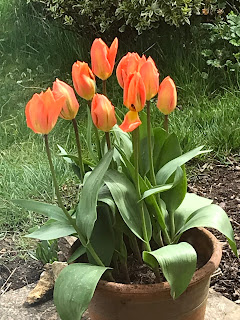I have a love-hate relationship with seed cells. They can be great for raising seedlings up to potting-on or planting-out stage: easy to fill with compost, and more convenient than lots of individual small pots; the seedlings can be easily moved en masse rather than the fiddly business of transporting several little pots. It’s not so easy to get the seedlings out with all their roots intact, mind you; much of the compost tends to get left behind when you prise them out, but with a little care they can be extracted without too much damage.
On the other hand: well, there are a number of disadvantages. My success rate with seeds isn’t all that it
might be (too many old packs of seed!), and often I find that each set of cells
ends up with only a very few actual seedlings in it, and I’m taking up space in
the greenhouse / cold frame / propagator with a number of empty cells. Then, all the seedlings have to be dealt with
at the same time; if some seeds are still germinating and need the extra heat
or protection of the propagator or whatever, while their neighbours are further
ahead and are ready to be potted on, I have to hold back the latter or sacrifice
the former. I can create a problem by sowing two or more different lots of seeds in the same cell-pack, as not all will necessarily germinate at the same rate. Likewise if –
as has happened with my lettuce seedlings – some are eaten or damaged by slugs or
snails while the rest are growing away fine, I have to give house-room to cells
with no viable seedlings in them. (The
lettuces had been germinated in the cold frame, with no pest damage; then, once
pricked out into the cells, they fell prey to a snail that got into the frame. The snail was removed and thrown into the
field across the road.)
 |
| Lettuce seedlings - grazed by the snail! |
At least the propagator is pest-proof. But here’s a conundrum. In there I have a cell-pack containing three different sets of seeds: spring onions, dill and coriander. At least, that’s what the plant labels say; for once, I did actually label them, but did I label them correctly? The seedlings that are rather patchily coming up all look the same. The two in the ‘spring onions’ cell are definitely not spring onions (and there are no signs of the actual onions – in fairness, that was probably old seed). There are two ‘coriander’ seedlings, one of which has the remains of the outer seed coating still stuck to its leaves, and that does indeed look like a coriander seed, which is fairly distinctive. The ‘dill’ seedlings seem to be doing well – but why did I sow dill in here, when I have other dill seedlings germinating successfully in the cold frame? And those look different to – and much more dill-like than – the propagator seedlings. A quick nibble of one of the propagator occupants tells me that these ‘dill’ seedlings are indeed herbs, but they don't taste like dill; they may be more coriander, which is useful but puzzling. Did I sow two rows of coriander – and spill some seed into the ‘onions’ cells – and mislabel one row as dill? Time, I suppose, will tell once the true leaves appear!
 |
| Conundrum |
Most of my dahlia tubers got separated from their labels in
storage, but they are starting to sprout nicely in the greenhouse. Perhaps the weather will warm up enough to
plant them out later in the spring! The weather continues to be depressingly wet, although the forecast is for a dry weekend,
which might allow us to mow the lawn at last.
A windy few days knocked the ‘Exotic Emperor’ tulips about, but the ‘Orange
Emperor’ ones (in a slightly more sheltered position) are still standing, and tulips ‘Dreamer’
and ‘Havran’ are coming up together in one of the larger pots (there ought to
be ‘National Velvet’ in there too; is it a later variety?). ‘Dreamer’ is pretty, but not multi-headed as
the catalogue suggested (which is a pity as it was a more expensive variety).
And there’s always one rogue bulb in every order: a lovely delicate
little, mutiheaded, soft yellow daffodil has appeared in the pot of ‘Elka’ daffs. I wish I knew what it is, so that I could get
more for next year!
 |
| 'Elka' - and an unknown yellow interloper |
At least I did better than a friend in the village, whose potful of tastefully selected pink tulips has turned out to be a mixture of red, yellow and purple.



No comments:
Post a Comment